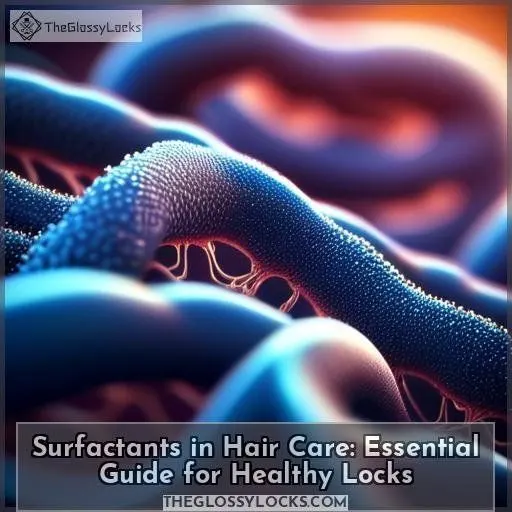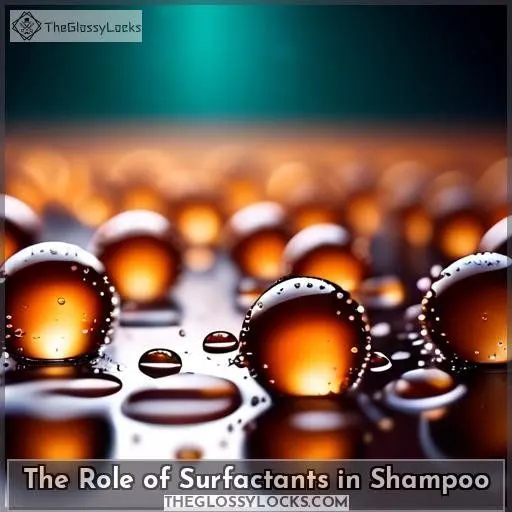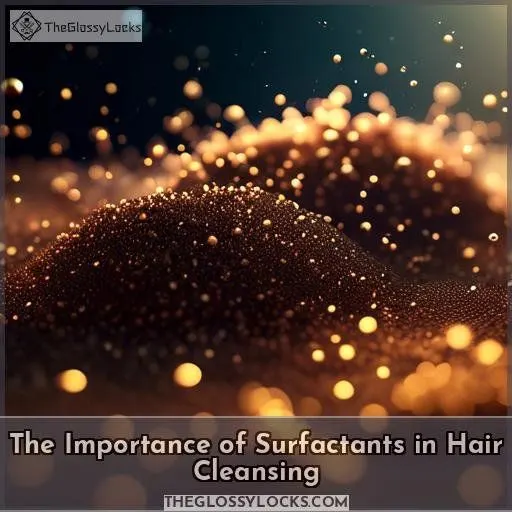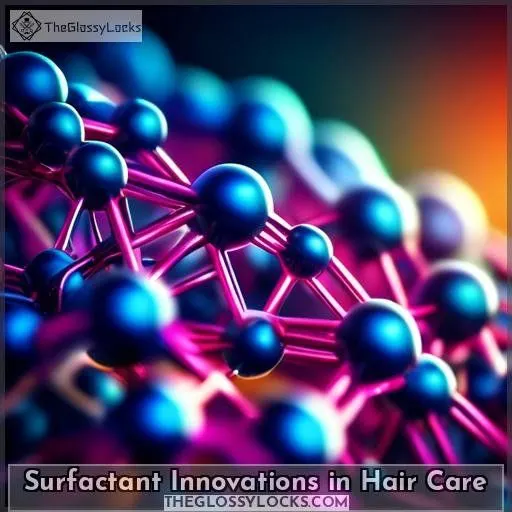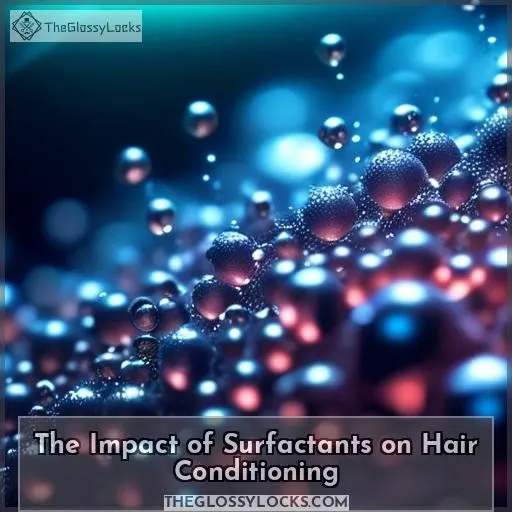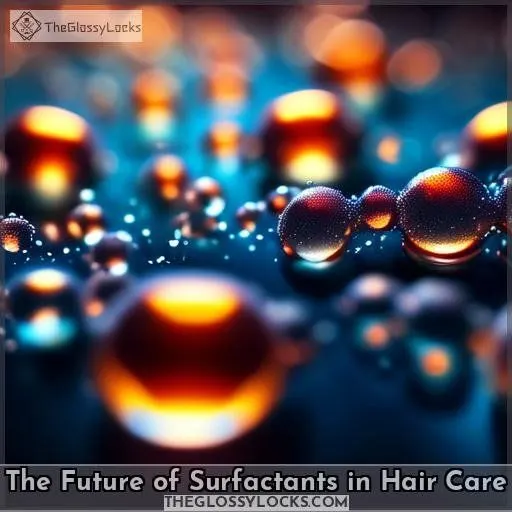This site is supported by our readers. We may earn a commission, at no cost to you, if you purchase through links.
Surfactants are essential in hair care, playing a critical role in shampoo composition and hair cleansing. They come in different types, including anionic, cationic, nonionic, and amphoteric, each with unique characteristics and performance.
Surfactants are responsible for emulsifying dirt on hair and scalp, and their structure determines their effectiveness. When choosing surfactants for hair types, consider curly hair’s need for gentle detergents and conditioning shampoos, or low poo routines that avoid buildup.
Innovations in surfactant technology include optimizing cationic polymers for better conditioning and reducing irritation, as well as using polymeric thickeners to enhance consistency and texture. Sustainable surfactant options are also available, ensuring eco-friendliness.
The future of surfactants in hair care promises new technologies and customized solutions for specific hair needs.
Table Of Contents
- Key Takeaways
- The Role of Surfactants in Shampoo
- The Importance of Surfactants in Hair Cleansing
- Choosing the Right Surfactants for Hair Types
- Surfactant Innovations in Hair Care
- The Impact of Surfactants on Hair Conditioning
- Surfactant Safety and Environmental Considerations
- The Future of Surfactants in Hair Care
- Frequently Asked Questions (FAQs)
- Conclusion
Key Takeaways
- Surfactants play a critical role in hair care, with different types like anionic, cationic, nonionic, and amphoteric each having unique characteristics and performance.
- Innovations in surfactant technology include optimizing cationic polymers for better conditioning and reducing irritation, as well as using polymeric thickeners to enhance consistency and texture.
- Sulfate-free and silicone-free shampoos are becoming increasingly popular due to their potential benefits for scalp health and environmental impact.
- Understanding surfactant functions and structure is vital for selecting appropriate surfactants for different hair types and ensuring effective hair cleansing.
The Role of Surfactants in Shampoo
Surfactants play a vital role in shampoo composition, as they’re responsible for cleansing and conditioning your hair. Anionic, cationic, nonionic, and amphoteric surfactants are all used in shampoos, with each type offering distinct benefits. Sulfate-free and silicone-free shampoos are also becoming increasingly popular for their potential to reduce skin and eye irritation and environmental impact.
Anionic, Cationic, Nonionic, and Amphoteric Surfactants
Anionic, cationic, nonionic, and amphoteric surfactants are the four main types of surfactants used in shampoo formulations. Each type has unique properties and functions that contribute to the overall performance of the shampoo.
Anionic surfactants, such as sodium lauryl sulfate (SLS) and sodium laureth sulfate (SLES), are known for their strong cleaning ability and lathering properties. However, they can be harsh on the scalp and hair, leading to dryness and irritation. To address this, manufacturers are increasingly using more gentle anionic surfactants, like amino acid surfactants, to create sulfate-free shampoos.
Cationic surfactants, such as Cetyltrimethylammonium chloride and Benzalkonium chloride, are positively charged and have good bactericidal and anti-static properties. They’re commonly used as a disinfectant and conditioning agent in a variety of home care and personal care products. However, they interact with anionic surfactants and can form insoluble salts, making them unsuitable for use in shampoo formulations where anionic surfactants are present. Instead, cationic polymers are used to offer conditioning properties and to formulate 2-in-1 shampoos.
Nonionic surfactants, such as cocamide DEA and Cocamide MEA, don’t carry an electrical charge and are generally less harsh than other types of surfactants. They’re used in shampoo and other personal care formulations for their mildness and their outstanding ability to create a rich lather. Nonionic surfactants often have good thickening ability, which can help to build a thick body texture for the shampoo. However, some nonionic surfactants, like alcohol ethoxylates and alkylphenol ethoxylates, can be harsh on the skin, defoaming, and don’t help to thicken a solution.
Amphoteric surfactants, also known as zwitterionic surfactants, have both positive and negative charges and can behave as either anionic or cationic, depending on the pH of the solution. They’re very mild cleansers, so they’re usually used as co-surfactants in a surfactant blend. They’re also used to help stabilize lather and strengthen the micelles that help cleansing surfactants remove dirt and oil. Examples of amphoteric surfactants include cocamidopropyl betaine, babassuamidopropyl betaine, and sodium cocoamphoacetate.
Sulfate-Free and Silicone-Free Shampoos
Sulfate-free and silicone-free shampoos are gaining popularity due to their potential benefits for scalp health and environmental impact. Sulfates, such as sodium lauryl sulfate and sodium laureth sulfate, can cause irritation, dryness, and scalp issues. Silicones, on the other hand, can create a barrier that prevents moisturizing ingredients from reaching the hair strand and can lead to buildup and dullness over time.
To address these concerns, many companies have developed sulfate-free and silicone-free shampoos. These products often rely on alternative surfactants, such as cationic polymers, to create a lather and cleanse the hair without stripping it of natural oils. Some sulfate-free shampoos also incorporate polymeric thickeners, such as xanthan gum, hydroxyethyl cellulose, and hydropropyl methylcellulose, to increase viscosity and improve the shampoo’s performance.
When choosing a sulfate-free and silicone-free shampoo, it’s important to think about your hair type and concerns. For example, if you have oily hair, you may prefer a shampoo with a higher concentration of cleansing agents, while those with dry hair may benefit from a more hydrating formula. Additionally, it’s critical to check the label carefully and verify that the product is sulfate-free and silicone-free, as some brands may still include these ingredients in their formulations.
The Importance of Surfactants in Hair Cleansing
Surfactants play an essential role in hair cleansing by emulsifying oily dirt on hair and scalp, allowing dirt to be pulled into water and washed off. Understanding the functions and structure of surfactants is vital for selecting the appropriate surfactants for different hair types and ensuring effective hair cleansing.
Surfactant Functions
Surfactants play a pivotal role in shampoo composition, enhancing its cleansing efficiency and conditioning qualities. They’re responsible for the foam formation and water-repelling attraction, which emulsify oily dirt on hair and scalp, enabling it to be rinsed away.
Surfactant toxicity is a consideration, but eco-friendly surfactants, such as those originating from sustainable sources, are gaining acceptance.
Conditioning agents and wetting agents are essential for preserving hair health and addressing scalp conditions like dandruff.
Comprehending surfactant functions is critical for selecting the appropriate shampoo for your hair type and achieving ideal cleansing and conditioning.
Surfactant Structure
Surfactant structure plays a pivotal role in determining their characteristics and performance in hair cleansing. Surfactants are comprised of hydrophilic and hydrophobic segments, which can be categorized into anionic, cationic, nonionic, and amphoteric types. The hydrophilic segment is responsible for attracting water, while the hydrophobic segment interacts with oils and dirt on the hair and scalp.
Surfactant synthesis is a multifaceted process that involves the utilization of various raw materials and chemical reactions. Biosurfactants, derived from natural sources such as microorganisms, offer a more sustainable alternative to synthetic surfactants.
In hair care, surfactants are utilized in cleansing conditioners and shampoos to eliminate dirt, perspiration, and product residue. However, their structure can influence their ability to cleanse effectively. For instance, powerful surfactants with short hydrophobic chains provide abundant lather but can be abrasive to the hair, while mild surfactants with long hydrophobic chains provide minimal lather but are more gentle.
Comprehending surfactant structure is fundamental for selecting the appropriate surfactants for different hair types and cleansing routines. It can aid in preventing product buildup, preserving hair health, and ensuring the effectiveness of hair care products.
Choosing the Right Surfactants for Hair Types
Regarding curly hair, selecting appropriate surfactants is essential for sustaining healthy tresses. Harsh surfactants can lead to discomfort, frizziness, and aridity, whereas gentle surfactants cleanse mildly without removing hair’s inherent oils. Comprehending the disparities between surfactants and their consequences for hair enables you to make well-informed choices about your hair care regimen.
Surfactants in Curly Hair Products
Regarding curly hair, selecting appropriate surfactants is vital for attaining desired results. Here are four factors to contemplate:
- Mild Detergents: Curly hair tends to be dry and frizzy. Mild detergents, such as those including Cocamidopropyl Betaine, cleanse gently without depleting natural oils.
- Subtle Surfactants: Shampoos with minimal lather are frequently more delicate on curly hair. They prevent accumulation, which is paramount for maintaining healthy hair.
- Conditioning Detergents: Certain shampoos are formulated to condition while cleansing. These can be advantageous for curly hair, as they aid in preserving moisture and preventing damage.
- Purifying Shampoo: Occasionally, buildup from oils, butter, or hard water minerals can occur. A purifying shampoo can assist in eliminating this buildup, guaranteeing that your curls remain healthy and radiant.
Low Poo or Sulphate-Free Hair Routines
Low poo or sulphate-free hair routines have become increasingly popular in the curly hair community due to concerns about the potential damage caused by strong surfactants, such as sulphates, found in many shampoos. However, these routines come with their own set of challenges, particularly when it comes to cleansing and maintaining hair health. In this section, we’ll discuss the importance of surfactant buildup, cleanser selection, and moisture penetration in the context of low poo or sulphate-free hair routines.
Surfactant buildup is a common issue in hair care, particularly when using mild surfactants or co-washing with cleansing conditioners. Mild surfactants, such as Cocamidopropyl Betaine, are gentler on hair and scalp but may not effectively remove oils and butter buildup from hair. This buildup can prevent moisture penetration, leading to dry hair, breakage, and an itchy scalp. In addition, oils and butter in hair care products can exacerbate buildup, and gentle cleansers can deposit molecules that further hinder moisture penetration.
To address these challenges, it’s essential to choose cleansers with surfactants appropriate for your hair regimen and product use. Clarifying shampoos may be necessary to remove buildup from oils, butter, and hard water minerals. Consider factors such as water quality, lifestyle, and frequency of hair washing when selecting cleansers. Assess your hair condition and adjust your cleansing routine as needed. Using a variety of cleansers with varying surfactant strengths can help maintain hair health.
Surfactant Innovations in Hair Care
Optimize cationic polymers and explore polymeric thickeners to create viscosity in sulfate-free shampoos, paving the way for innovative hair care products.
Optimization of Cationic Polymers
Optimizing the functionality of cationic polymers is essential for the development of sulfate-free shampoos, which are increasingly popular due to their potential to reduce skin and eye irritation or contact allergy. Cationic polymers play a significant role in providing conditioning and antistatic properties in shampoo formulations, aiding in the deposition of other ingredients, and enhancing the performance of surfactants.
To optimize the cationic polymer’s impact on shampoo viscosity, several strategies can be employed. One approach is to investigate the molecular weight and charge density of the cationic polymer, as these factors can influence its effectiveness as a conditioner. Another strategy is to explore the use of cationic polymers with high molecular weight, which can provide better conditioning properties in shampoos based on anionic surfactants.
Innovations in cationic polymer technology can also address the challenges associated with sulfate-free shampoos. For example, the development of new cationic cellulosic polymers can provide formulators with a natural, bio-derived alternative to traditional cationic polymers, offering improved performance regarding conditioning and reduced grooming forces.
Moreover, the optimization of cationic polymers can contribute to the development of more sustainable surfactant options. By incorporating biodegradable, cationic cellulosic polymers into shampoo formulations, the environmental impact of personal care products can be reduced.
Polymeric Thickeners
Polymeric thickeners are an important component in the development of thickening agents for various applications, including shampoos. These thickeners are formed from monomers such as acrylic acid and methacrylic acid, with preferred copolymers containing 20 to 60% by weight of these acids, often methacrylic acid alone. The use of polymeric thickeners can enhance the consistency and texture of products, making them more appealing to consumers.
In the context of shampoo, polymeric thickeners are used to increase the viscosity and overall feel of the product. They can help maintain the desired consistency and stability of the shampoo, ensuring that it performs well and provides a pleasing sensory experience for the user.
When selecting polymeric thickeners for shampoo manufacturing, it’s essential to take into account factors such as compatibility with other ingredients, viscosity control, appearance, environmental impact, and cost-effectiveness. Some popular natural thickeners for shampoo include xanthan gum, guar gum, and cellulose derivatives, which offer a range of benefits such as thickening, stabilizing, and emulsifying properties.
In terms of safety and environmental considerations, polymeric thickeners can be derived from renewable resources, making them a more eco-friendly option. Additionally, some thickeners may have a lower environmental impact than others, aligning with the growing trend towards sustainable ingredients in personal care products.
As the demand for natural and eco-friendly ingredients continues to grow, the development of new polymeric thickeners with improved properties is a key area of research and innovation in the personal care industry. This includes the development of thickeners with higher viscosity, better heat stability, and a more natural profile, which can enhance the overall performance and appeal of shampoo products.
The Impact of Surfactants on Hair Conditioning
Surfactants play a key role in hair conditioning by enhancing the deposition of conditioning agents onto the hair. Conditioning shampoos and sulfate-free and silicone-free conditioners are designed to deposit conditioning actives onto the hair while washing off dirt. These conditioning actives include silicones and conditioning oils, which provide smoothness, softness, and shine to dried hair.
The coacervate formed by cationic polymers and anionic surfactants provides wet hair conditioning. Amino acid-based anionic surfactants are reported to be milder than traditional sulfate-based ones.
Conditioning Shampoos
- Conditioning Agents: These are the stars of conditioning shampoos, providing smoothness, softness, and shine to dried hair. Silicones, such as dimethicone, and conditioning oils are common conditioning agents.
- Silicone Benefits: Silicones are renowned for their ability to coat hair strands, reducing friction and enhancing the overall appearance of hair. They can also help protect hair from environmental damage.
- Cationic Conditioning: Cationic surfactants, like polyquarternium-10, cling to hair shafts and are resistant to rinsing. They provide a softening effect and are typically found in hair conditioners.
- Amphoteric Gentleness: Amphoteric surfactants, like cocamidopropyl betaine, are milder than their anionic counterparts. They provide decent lather and don’t dry hair and scalp, making them suitable for sensitive scalps and young children.
Conditioning shampoos are designed to deposit conditioning actives onto hair while washing off dirt. The right combination of surfactants and conditioning agents can help maintain personal hygiene without stripping hair of its natural oils. Sulfate-free and silicone-free shampoo innovations are changing the game, offering gentler options for those with sensitive scalps or environmental concerns.
Sulfate-Free and Silicone-Free Conditioners
Sulfate-free and silicone-free conditioners are becoming increasingly popular due to their gentle cleansing properties and eco-friendly options. These conditioners are designed to provide the benefits of conditioning without the harsh effects of sulfates or the potential environmental concerns associated with silicones.
In the table below, we compare the benefits of sulfate-free and silicone-free conditioners to traditional conditioners, highlighting their gentle cleansing properties and natural alternatives.
| Benefits | Sulfate-Free Conditioners | Silicone-Free Conditioners | Traditional Conditioners |
|---|---|---|---|
| Gentle Cleansing | Minimizes irritation and dryness | Promotes hair health and shine | May contain harsh sulfates |
| Natural Alternatives | Plant-based ingredients | Minimizes environmental impact | May contain synthetic ingredients |
| Eco-Friendly Options | Biodegradable and recyclable packaging | Reduces silicone waste in oceans | May contribute to plastic pollution |
Surfactant Safety and Environmental Considerations
It’s essential to evaluate the safety and environmental consequences of surfactants in hair care products. Immediate and short-term toxicity can create hazards to users, while eco-friendly surfactant options can reduce harm to the environment.
Acute and Short-Term Toxicity
Regarding surfactants in hair care, safety is paramount. Comprehending the immediate and short-term toxicity of these ingredients is vital for guaranteeing their safe usage. Here are four essential considerations:
Safety evaluations: Surfactants undergo rigorous safety evaluations to determine their potential for inducing irritation or allergic reactions. These evaluations help identify any hazards associated with their use.
Irritation hazards: Certain surfactants can cause irritation, particularly when used in high concentrations or on delicate skin. It’s imperative to opt for surfactants with a minimal irritation risk for your hair care products.
Allergic reactions: Allergic reactions occur when the immune system responds to a substance, triggering allergy-like symptoms. Some surfactants have been linked to allergic reactions, so it’s crucial to avoid them if you’re susceptible to allergies.
Environmental concerns: Surfactants can also affect the environment, potentially harming aquatic life. It’s important to choose surfactants with low ecotoxicity to minimize their environmental impact.
Sustainable Surfactant Options
Diving into the realm of sustainable surfactant choices, you’ll discover that eco-conscious surfactants aren’t merely a ripple in the vast expanse. These biodegradable surfactants, often sourced from plant-based origins, are creating a stir in hair care. They’re the unheralded guardians, ensuring your tresses remain radiant without burdening Mother Earth.
Envision utilizing shampoos that cleanse with the delicate embrace of natural surfactants, derived from renewable resources. It’s akin to bestowing your hair with a nurturing caress from nature itself. These verdant allies provide a guilt-free avenue to hair care, demonstrating that what nourishes the planet can also be exceptional for your follicles.
The Future of Surfactants in Hair Care
As the demand for safer and more environmentally friendly hair care products grows, new surfactant technologies and customized surfactant solutions are emerging. These innovations aim to provide more effective cleansing and conditioning while minimizing potential harm to both consumers and the environment.
New Surfactant Technologies
As we venture deeper into the sphere of surfactants in hair care, it’s time to investigate the groundbreaking technologies that are shaping the future of this field. From micellar technology to antimicrobial surfactants, bio-based surfactants, hybrid surfactants, and natural surfactants, these innovations are transforming the way we cleanse and condition our hair.
Micellar technology, for instance, utilizes the strength of minuscule micelles to gently lift and remove dirt, oil, and impurities from our hair and scalp. Antimicrobial surfactants, on the other hand, provide an additional layer of protection against bacteria and fungi, ensuring a cleaner, healthier scalp.
Bio-based surfactants, derived from renewable sources, are a sustainable substitute for traditional surfactants, minimizing our environmental impact. Hybrid surfactants, a fusion of different surfactant types, offer the best of both worlds – effective cleansing and gentle conditioning.
Natural surfactants, derived from plants and other natural sources, are gaining popularity for their eco-friendliness and gentleness on hair and scalp. These novel surfactant technologies aren’t merely about innovation; they empower us to make informed choices that align with our values and preferences.
Customized Surfactant Solutions
In the domain of hair care, surfactant innovation is like a culinary artist’s signature sauce—customized to perfection. Envision crafting personalized surfactant concoctions that cater to your locks like a tailored ensemble, providing a liberating sense of mastery over your mane’s fate.
As surfactant advancements unfold, the pursuit of surfactant alternatives becomes a mission for both scalp well-being and environmental protection. The future whispers promises of surfactant eco-friendliness, where your tresses revel in the radiance of environmentally conscious care without sacrificing that opulent lather.
It’s a decisive departure from universal solutions, navigating towards a horizon where your hair’s needs are the guiding star.
Frequently Asked Questions (FAQs)
How do surfactants affect hair color?
Surface-active agents play a key role in hair care, including hair color. They can affect hair color in various ways, depending on their type and formulation. Surface-active agents in hair dye products can interfere with the absorption of basic dyes to hair, potentially reducing the color resistance of the dye. The choice of surface-active agent can also influence the color retention of hair dyes. For example, positively charged surface-active agents like cetrimonium chloride and cetrimonium methosulfate can enhance color retention in hair dyes.
In shampoo formulations, surface-active agents can affect the color retention of hair dyes. For instance, the amphoteric surface-active agent cocoamidopropyl betain (CAPB) has been shown to offer statistically significant improved color retention compared to nonionic surface-active agents in shampoo formulations. Additionally, silicone-based conditioning additives can deliver enhanced color retention in comparison with selected positively charged surface-active agents.
It is important to take into account the type of surface-active agent and its interaction with the hair dye when evaluating the impact of surface-active agents on hair color.
Can surfactants cause hair loss?
Surfactants, such as sodium lauryl sulfate and sodium laureth sulfate, can cause hair loss when used in high concentrations. These surfactants can strip hair of its natural proteins, leading to weaker hair and increased breakage. However, not all shampoos containing surfactants cause hair loss, and the effects can vary depending on factors such as concentration and individual hair type.
How do surfactants interact with hair extensions?
Surfactants in shampoos can strip hair extensions of natural oils, leaving them dry and brittle, so it’s wise to opt for sulfate-free options to keep those locks luscious and long-lasting.
Can surfactants cause hair tangles?
Surfactants can cause hair tangles, especially when used in sulfate-free shampoos or products with coco-glucoside or lauryl glucoside as the main surfactant. These surfactants have a higher molecular structure, which can lead to increased friction and mechanical damage, resulting in tangles and frizz.
The alkaline pH of these shampoos can also lift the cuticle cells, causing more friction and damage. To avoid tangles, it’s crucial to use the right surfactants for your hair type and regimen.
Consider using a clarifying shampoo to remove buildup and adjust your cleansing routine to maintain hair health.
How do surfactants impact hair growth?
Surfactants play a significant role in hair growth by aiding in the elimination of dirt, oil, and other impurities from the hair and scalp. They create a lather that assists in distributing the shampoo uniformly across the hair, enhancing its cleansing effectiveness.
However, not all surfactants are equivalent. Some, such as anionic surfactants, can be abrasive and stripping, potentially causing dryness, frizz, or irritation. Others, such as cationic surfactants, are frequently employed as conditioning agents to minimize static and enhance manageability.
The selection of surfactant is dependent on the specific hair regimen and product usage. Clarifying shampoos may be essential to eliminate buildup from oils, butter, and hard water minerals. Appropriate surfactant selection and treatment of hair and scalp can contribute to the maintenance of healthy hair growth.
Conclusion
Surfactants are the foundation of hair care, and their importance in shampoo formulation and hair cleansing is unmatched. With various categories including anionic, cationic, nonionic, and amphoteric, each possessing distinct properties, selecting the appropriate surfactants for your hair type is crucial.
Advancements in surfactant technology are enabling improved conditioning, decreased irritation, and environmentally conscious alternatives. The future of surfactants in hair care holds promise, with novel technologies and tailored solutions for specific hair requirements.
As you delve into the intricate world of surfactants, bear in mind that the well-being and aesthetic appeal of your hair rest upon these fundamental components.

